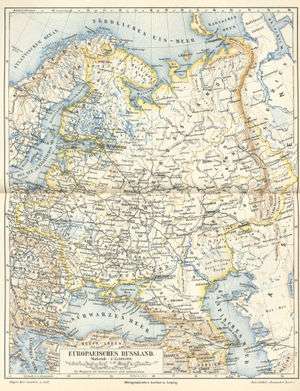Great Russia
Great Russia, sometimes Great Rus' (Russian: Великая Русь, Velikaya Rus', Великая Россия, Velikaya Rossiya, Великороссия, Velikorossiya), is a name formerly applied to the territories of "Russia proper", the land that formed the core of Muscovy and later Russia. This was the land to which the ethnic Russians were native and where the ethnogenesis of (Great) Russians took place. The name is said to have come from the Greek Μεγάλη Ῥωσ(σ)ία, Megálē Rhōs(s)ía[1] used by Byzantines for the northern part of the lands of Rus'.

From 1654–1721, Russian Tsars adopted the word - their official title included the wording (literal translation): "The Sovereign of all Rus': the Great, the Little, and the White".
Similarly, the terms Great Russian language (Великорусский язык, Velikorusskiy yazyk) and Great Russians (Великороссы, Velikorossy) were employed by ethnographers and linguists in the 19th century, but have since fallen out of use.
However, the area became, together with the Volga-Ural region, North Caucasus and Siberia, the Russian SFSR, while Little Russia and White Russia became the Ukrainian SSR and the Byelorussian SSR respectively.
Related topics
- Etymology of Rus and derivatives: From Rus' to Rossiya
- Greater Poland
- Little Russia
- Novorossiya (New Russia)
- White Russia (disambiguation)
References
- Vasmer, Max (1986). Etymological dictionary of the Russian language. Moscow: Progress. p. 289.